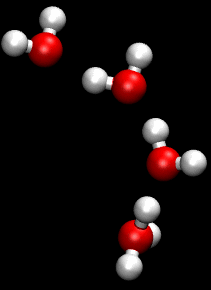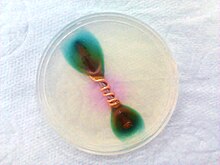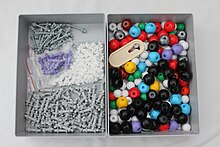Model (chemistry)


In chemistry, models are devised and used on the basis of macroscopic or microscopic observations and test results, with which conclusions can be drawn about the properties and reactions of atoms , ions , molecules and substances . They also serve to illustrate particles and reactions. All statements about the submicroscopic area have a model character , since this area is often not directly accessible to the observer. Models are not only important for research, but also especially for chemistry classes and chemistry studies .
Principles
A distinction can be made between the following types of models:
- Ideal models are conceptual constructs (thought models),
- Material models or factual models serve to illustrate ideal models and, in principle, also belong to the media .
A large area in chemistry is made up of models of the structure of matter ( particle models) and models of chemical bonds . The thought models initially developed are usually illustrated by suitable material models. The idea of a covalent bond is an ideal model that z. B. can be illustrated in the simplest form by a ball-and-stick model or an electron formula. The idea of an ionic bond can be prepared by a grid model , the idea of the spatial arrangement of atoms in a molecule can be obtained by a space-filling model or orbital model are illustrated.
The following requirements should be made of the models:
- Clarity,
- Simplicity,
- Transparency,
- Opportunities for further development,
- Coherence between several models: Models of a superordinate structure must match the subordinate structure.
Reaction equations , reaction types or reaction mechanisms and kinetic considerations are models of the reactions that have taken place and are described and represented with the help of suitable media. Kinetic considerations can be well supported by simulations (e.g. computer simulations ). Experiments often have a model character, especially since they usually simplify reality. They can also be used as a functional model to illustrate application-related and technical processes.
swell
- Günter Keller: About thinking in models, Verlag Diesterweg Salle / Sauerländer 1977, ISBN 3-425-07027-4
- Ernst Kircher, Alfred Teßmann (ed.): Atomic models in class, IPTS-Schriften Volume 15, Verlag Schmidt and Klaunig 1977, ISBN 3-88312-112-6
- Christhardt Tröger: Thoughts on the use of models in chemistry lessons, Praxis der Naturwissenschaften Chemie 9/1980, p. 269, Aulis Verlag Cologne
- Hans-Dieter Barke: The indispensability of structural models for the understanding of chemical reactions, Praxis der Naturwissenschaften Chemie 12/1980, S. 372, Aulis Verlag Cologne
- Models and model experiments, practical science - chemistry in school 2/2003, Aulis Verlag Cologne

